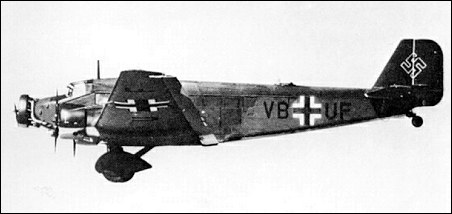 |
Junkers Ju-52/3m1932 |  |
| PASSENGER, TRANSPORT, BOMBER | Virtual Aircraft Museum / Germany / Junkers |
 |
Built in larger numbers than any other European transport aircraft before or since, this extremely robust machine combined exceptional qualities of payload, STOL and all-round utility that resulted in a very long active life. The original prototype (flown in May 1932) was a Ju 52 redesigned to be powered by three engines. Most early civil examples had the 447kW BMW Hornet engine, made under Pratt & Whitney licence; but the vast bulk of later sub-types had the derived engine known as the BMW 132, rated at 507-618kW. Like the original single-engined Ju 52, the tri-motor transport had a structure wholly of light alloy with corrugated skin and a very large cantilever wing-with patented 'double wing' flaps and ailerons giving great lift at low airspeeds. The fixed landing gear was almost unbreakable and on a few examples had spats; float-seaplane and ski versions were not uncommon. In World War II the vast numbers of Luftwaffe transports (more than 90% of which were of this basic type) changed landing gear to suit the local terrain and climate. The Ju 52/3m was by far the leading European civil airliner of the 1930s, seating 15 to 17 in single seats each side of the central aisle. It carried more than 75% of Luft-Hansa's Europe-wide traffic in the 1930s, the airline using at least 120. Exported civil models had Wasp, Hornet and Pegasus engines, and a small number in Germany had Jumo diesels. In 1935 the first 3mg3e bombers reached the Luftwaffe, with 1,500kg of bombs and MG 15 machine-guns in a dorsal cockpit and ventral 'dustbin'. In 1936 about half the total production (450) of this model were serving as transports or bombers with the Condor Legion in Spain.
Total production of all models was about 4,845 on German account, 575 of which were completed before 1940. German plants then made a further 2,659, the rest comprising output by Amiot for the Luftwaffe. The latter was continued post-war by the AAC which delivered 400 by 1947 with the designation AAC.1. A further 170 were built by CASA in Spain. More than 3,500 served with the Luftwaffe, nearly all in the transport role with the popular names 'Tante Ju' (Auntie Ju) and 'Iron Annie'. The most-produced wartime types were the 3mg5e, 7e, 8e and 14e, though differences were confined to such features as armament, loading arrangements, autopilot, glider couplings and crew armour. There were several non-transport versions, such as the g6eMS with a degaussing ring for exploding mines. After 1945 BEA used a fleet on internal services and the Spanish T.2B version was not withdrawn until 1975. One of the last, with the Swiss Air Force, was still active in 1979.

|  COMPANY PROFILE | |||||||||||||||||||||||||||||||||||||||||||||||||||||||||||||
 |

|


